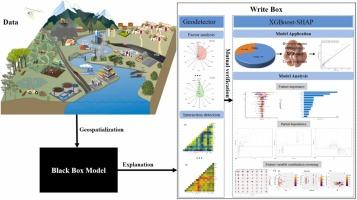Revealing the synergistic spatial effects in soil heavy metal pollution with explainable machine learning models
IF 12.2
1区 环境科学与生态学
Q1 ENGINEERING, ENVIRONMENTAL
引用次数: 0
Abstract
The identification of factors that affect changes in the heavy metal content of soil is the basis for reducing or preventing soil heavy metal pollution. In this research, 16 environmental factors were selected, and the influences of soil heavy metal spatial distribution factors and the synergy amongst space factors were evaluated using a geographic detector (GD) and the extreme gradient boosting (XGBoost)-Shapley additive explanations (SHAP) model. Three heavy metal elements, namely, Cd, Cu and Pb, in the study region were examined. The following results were obtained. (1) XGBoost demonstrated high accuracy in predicting the spatial distributions of soil heavy metals, with each heavy metal having an R2 value of over 0.6. (2) Geological type map (Geomap) and enterprise density considerably affected the concentrations of Cd, Cu and Pb in soil in the GD and XGBoost-SHAP models. In addition, cross-detection revealed strong explanatory power when natural and human factors were combined. (3) Under the same geological background, the different trends of gross domestic product effects on heavy metals indicated that pollution control measures were effective in economically developed areas, and the economy and the environment could be balanced. Meanwhile, the interaction between the normalised difference vegetation index and enterprise density showed that vegetation could alleviate heavy metal pollution in the region. This study supports strategic decision-making, serving as a reference for the global management of soil heavy metal contamination, sustainable ecological development and assurance of people’s health and well-being.

用可解释的机器学习模型揭示土壤重金属污染的协同空间效应
确定影响土壤重金属含量变化的因素是减少或预防土壤重金属污染的基础。本研究选取了 16 个环境因子,利用地理检测器(GD)和极端梯度提升(XGBoost)-沙普利加性解释(SHAP)模型评估了土壤重金属空间分布因子的影响及空间因子间的协同作用。对研究区域的三种重金属元素,即镉、铜和铅进行了研究。结果如下(1) XGBoost 在预测土壤重金属空间分布方面表现出较高的准确性,每种重金属的 R2 值均超过 0.6。(2)在 GD 和 XGBoost-SHAP 模型中,地质类型图(Geomap)和企业密度对土壤中镉、铜和铅的浓度有很大影响。此外,当自然因素和人为因素相结合时,交叉探测显示出很强的解释力。(3)在相同的地质背景下,国内生产总值对重金属影响的不同趋势表明,经济发达地区的污染控制措施是有效的,经济与环境可以达到平衡。同时,归一化差异植被指数与企业密度的交互作用表明,植被可以缓解该地区的重金属污染。本研究有助于制定战略决策,为全球土壤重金属污染治理、生态可持续发展和保障人民健康福祉提供参考。
本文章由计算机程序翻译,如有差异,请以英文原文为准。
求助全文
约1分钟内获得全文
求助全文
来源期刊

Journal of Hazardous Materials
工程技术-工程:环境
CiteScore
25.40
自引率
5.90%
发文量
3059
审稿时长
58 days
期刊介绍:
The Journal of Hazardous Materials serves as a global platform for promoting cutting-edge research in the field of Environmental Science and Engineering. Our publication features a wide range of articles, including full-length research papers, review articles, and perspectives, with the aim of enhancing our understanding of the dangers and risks associated with various materials concerning public health and the environment. It is important to note that the term "environmental contaminants" refers specifically to substances that pose hazardous effects through contamination, while excluding those that do not have such impacts on the environment or human health. Moreover, we emphasize the distinction between wastes and hazardous materials in order to provide further clarity on the scope of the journal. We have a keen interest in exploring specific compounds and microbial agents that have adverse effects on the environment.
 求助内容:
求助内容: 应助结果提醒方式:
应助结果提醒方式:


